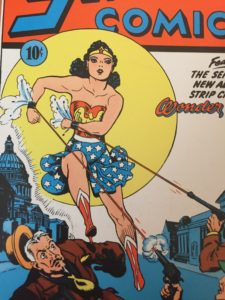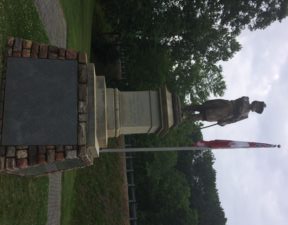These past two weeks, I’ve spent the majority of my time working on Administrative work, my own project, and small assignments for the museum. Besides this, I also did another In The Moment, this time with the Prohibition Exhibit and was joined the educators on a tour given by the curator on a new exhibit on Lumen Martin Winter’s and his artwork.
I’ve been continuously gathering more information I feel is relevant for my Industrialization program at the museum. I was able to go with the curator of the museum and find relevant documents. One section of the permanent collection at the museum is the Graves’ Workshop, a carriage building and repair shop that began pre-1850’s and through the early 1900’s. This section of the museum was donated to the museum by the Graves’ family, and the actual building was reconstructed inside of the museum on Long Island. I looked through the curators notes on the reconstruction, a family genealogy, photos of the Graves family, etc. The ledgers of business were also donated to the museum, and I have to chance to look through those too. Details of this were mentioned in a Memorandum piece in the file, such as “an 1878 customer Harris Guildford paid for his new Portland Sleigh with several cords of wood, 4 bushels of potatoes, and 7.5 pounds of butter, in addition to cash payments. […] This practice doesn’t seem to have lasted into 1900’s–customers in these ledgers paid primarily by cash or check.” While I haven’t had the chance to look through the ledgers yet, I find the opportunity (if I find I need to for my program) one that I would hate to miss.
Besides doing the research for this, I’ve been asked to design one page front-and-back small worksheets for children that go along with the permanent collection. I began by doing and “eye-spy” worksheet for two of the exhibits within the Carriage Museum; Going Places and Streets of NY. All of them are written in rhyming riddles, which was done on accident. My favorite one that I have written, out of the ten, is for the U.S Mail/Postal service carriage; “Unlike the other vehicles here, I have glass to protect the inside of me. I am special because I make special deliveries. Through wind, through rain, through snow, I’ll make it to your home. What am I?” I think they will be a great tool to have for children who are following along with their parents and learning at the museum. I also think I’m going to have a make-your-own Wall Label and a word search with clues from an art exhibit that was recently added to the museum as a temporary piece.
This new exhibit was filled with work from Lumen Martin Winters. I really enjoyed the tour because it gave me a chance to look at all of his artwork, and like the Prohibition tour, see the reasoning behind the displays. The curator, Jonathan, gave background information on a few pieces, pointed out his favorites, gave reasoning for the layout, and explained about the artist. My favorite piece that I saw was hanging, suspended from the ceiling. Lumen, the artist, worked in a lot of different media styles and liked to recycle. The piece was one that he had done, disliked, drawn a chalk mark through, flipped over and pained on the other side. On one side, the disliked side, was a landscape of a mountain range. The other side, which he enjoyed, was of a wisteria plant. I thought both pieces were beautiful, but I really thought his resourcefulness and recycling was interesting.
This time, the In The Moment tour was only for 2 seniors, which made it a little… slow. They were less talkative than the other group, and didn’t seem to be too interested in the Prohibition exhibit (although with prompting they did talk and begin to be more expressive). I thought this experience was good for me, because even though I was not the docent/educator for the group, it was a chance for me to get an example of what to do with a group of adults that is unresponsive to the material being given to them.
Below are two photos from these two weeks; they are from the Prohibition Exhibit and my research, respectively.
 This is a photo of the Prohibition Exhibit. It’s a scene of the fashions worn during the day, and what an upper class speakeasy would have looked like.
This is a photo of the Prohibition Exhibit. It’s a scene of the fashions worn during the day, and what an upper class speakeasy would have looked like.
This is a photo of pictures that had been photocopied of the Graves family. This is Norman, the founder of the original company, and his wife. This was located in their file at the museum.








